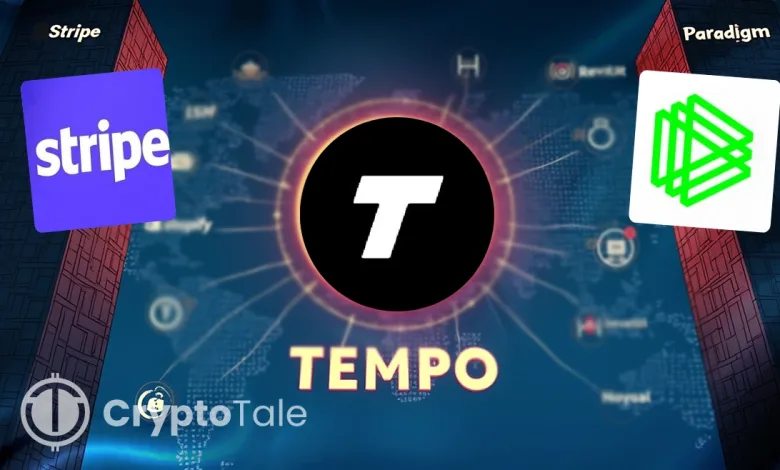Tempo Secures $500M to Build the Future of Stablecoin Payments

- Tempo’s $500M raise places it in direct competition with Circle’s stablecoin network.
- Stripe’s acquisitions and Base integration show a wider stablecoin payments push.
- Visa, OpenAI and Deutsche Bank as partners highlight early enterprise alignment.
Tempo secured $500 million in Series A funding this week in a round led by Thrive Capital and Greenoaks, valuing the payments-focused blockchain at $5 billion. The raise, involves backing from Sequoia Capital, Ribbit Capital, and SV Angel and comes less than two months after Stripe outlined the project alongside Paradigm. The funding positions Tempo as a contender in stablecoin-based settlement infrastructure built for real-world financial applications.
Stripe’s Layer 1 Push Draws Major Institutional Support
The funding follows Stripe CEO Patrick Collison’s September announcement that existing blockchains were not built to handle the scale of stablecoin transactions moving across Stripe, Bridge, and Privy.
He described Tempo as a payments-oriented Layer 1 built to process high-volume, real-world transactions. Although Stripe and Paradigm helped start the project, they didn’t invest money in this round but are still involved in its development.
The group of investors shows strong confidence from both fintech and venture capital firms in stablecoin payment systems. Thrive Capital and Greenoaks led the funding, joined by Sequoia, Ribbit Capital, and Ron Conway’s SV Angel.
Traditional investors moving into blockchain show growing interest in using dollar-backed crypto for payments and settlements. The $500 million raise also matches a broader trend, with more than $16 billion invested in crypto startups during Q3 2025.
The project hasn’t announced a launch date or a native token yet. Still, its focus on payments puts it in direct competition with Circle, the company behind USDC, which also plans to launch its own business-focused Layer 1 later this year to handle stablecoin payments, foreign exchange, and market transactions. USDC remains integrated with Visa and Mastercard and holds a market cap above $75 billion.
Stripe Expands Its Crypto Ambitions
Tempo forms part of Stripe’s wider crypto strategy, which includes acquisitions and technical partnerships. Stripe acquired Bridge for $1.1 billion to expand its stablecoin infrastructure and bought crypto wallet provider Privy earlier this year.
It also added support for Coinbase’s Base Layer 2 network to make blockchain payments smoother across its products. These steps point to a plan to take more control over different parts of payment technology.
Tempo’s link with Ethereum is meant to speed up transactions and make it easier for developers already working in that ecosystem. The project also plans to let users pay gas fees with different stablecoins, matching the needs of businesses and cross-border payments.
Several major companies have signed on as design partners. OpenAI, Shopify, Visa, Anthropic, and Deutsche Bank are reportedly collaborating with Tempo during its development phase. Their involvement gives the network early access to commercial use cases spanning digital services, retail payments, and institutional finance.
Related: OKX CEO and Brian Armstrong Align on Hybrid Finance Push
Paradigm and Tempo’s Direction
Paradigm co-founder Matt Huang, who also sits on Stripe’s board, is leading the initiative. The firm has worked closely with Stripe to guide the network’s roadmap while keeping it stablecoin agnostic.
This approach allows Tempo to work with different tokens without locking into a single issuer. The strategy also shows its goal to serve fintech methods before decentralized finance protocols. Technical leadership has expanded as well.
Dankrad Feist, a senior researcher from the Ethereum Foundation, joined Tempo as a senior engineer. His work on Ethereum scaling and consensus research brings experience in building high-performance networks. He said the project is aligned with open, permissionless architecture while designed for payments at scale.
Reactions to Feist’s move surfaced across crypto communities. Some Ethereum supporters expressed concern over talent changing to corporate-linked blockchains. Others emphasized the potential for stablecoin integration in everyday transactions. Vitalik Buterin acknowledged the transition publicly, while commentators debated the effect on open-source ecosystems.
Broader regulation continues to influence momentum. In the United States, the GENIUS Act established federal rules for stablecoin issuers. In Europe, euro-backed tokens are gaining traction as regulators look to balance dollar-based dominance. Circle’s forthcoming blockchain and Tempo’s funding both arrive amid rising institutional confidence in tokenized dollars as payment infrastructure.
The raise also shows interest from both Silicon Valley and Wall Street in payment-oriented blockchains. Stripe, now valued at $92 billion, has placed Tempo at the center of its crypto stack. Thrive Capital, Greenoaks, Sequoia, and Ribbit Capital have aligned on the expectation that stablecoin settlement will influence future commerce.
Tempo’s valuation places it among the most well-funded blockchain projects launched in recent years. Its focus on compliance, real-world payments and developer access positions it to compete with established stablecoin issuers and existing Layer 1 networks. With backing from major investors and corporate partners, the platform enters the market with significant financial and technical resources.
Meanwhile, the $500 million raise shows expanding demand for blockchain-based payment modes and growing alignment between fintech and crypto investors. Stripe’s involvement, combined with Paradigm’s technical backing, indicates a coordinated attempt to bridge stablecoins with mainstream financial systems. If adoption grows among enterprise partners, Tempo could influence how dollar-backed tokens move across global networks.





